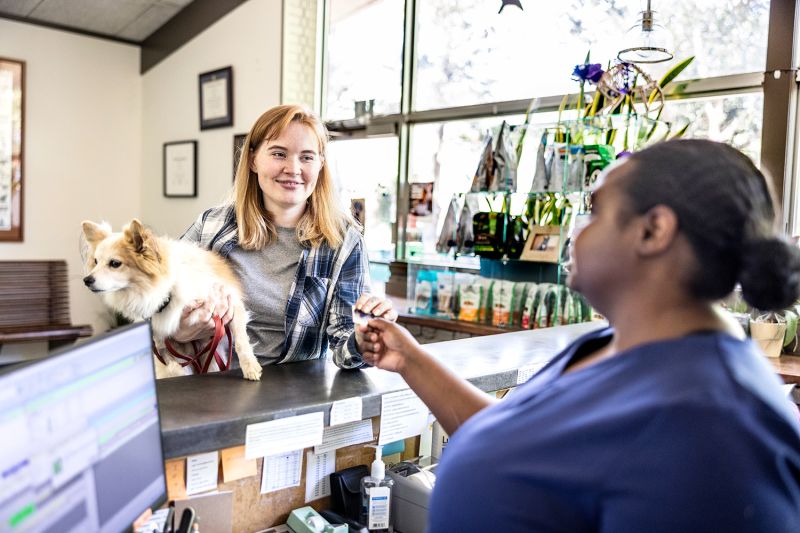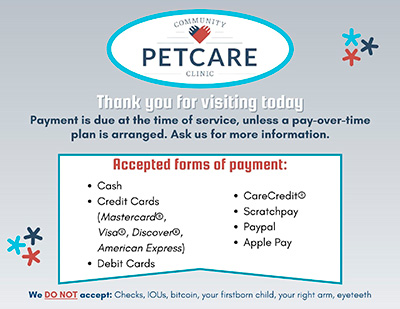Blog: How payment plans can increase access to veterinary care
Financial triage is a proven strategy to help more pets and families
February 3, 2025

What if I said you could turn a $75,000 grant into $500,000 worth of veterinary care for pet families with financial constraints by making one relatively simple change in how you do business? Would you want to give it a try?
A study led by the Open Door Veterinary Collective, published in Frontier Veterinary Journal, shows you can do just that.
The cash-flow issue
According to a report by the Access to Veterinary Care Coalition, cost is the No. 1 barrier for low-income families obtaining veterinary care for their pets. In an effort to remove that barrier, many nonprofits have begun offering deeply discounted and free services—but then often struggle to raise sufficient funds to meet the demand.
Financial barriers to vet care aren’t limited to low-income families. A 2021 survey found that 61% of Americans, and 70% of millennials, live paycheck to paycheck. Another recent study on financial fragility and access to veterinary care cites statistics from a George Washington University School of Business report which found that one in three U.S. households, including 30% of middle-income families and 20% of high-income families, are considered financially fragile—meaning they can’t come up with $2,000 within 30 days to cover an unexpected expense.
I’m a partner in two veterinary practices that explore and model sustainable strategies for making veterinary care accessible to all pet families. Our teams have learned it isn’t always about the cost of the service. More often, it’s a cash-flow issue, meaning people could pay if given time but just can’t afford a large bill all at once. We found that by simply offering a variety of payment options and pay-over-time plans using third-party providers, more pet parents can afford our services, enabling us to help more people and animals.
The best part is that our two clinics can maintain financial stability without continually scrambling to raise funds. And this is mirrored in the 42 veterinary clinics we’re currently mentoring and which are now starting to offer these plans.
How it works
Offering payment options is something you can do right now to expand your reach without hiring more staff or raising more funds. Here’s how we do it:
Step 1: Eliminate the stigma around clients’ financial limitations by normalizing the conversation. We list our payment options on our website, on signs in our lobby and in the exam rooms. All our staff members are well-versed in these options and trained to be comfortable talking with clients about their financial situations in a nonjudgmental conversation every step of the appointment.
Step 2: At the time of diagnosis, perform a “financial triage” by asking a few questions to help connect the family to the best option for them. This may sound like “Here is the breakdown of expected costs for your pet’s treatment today. Would you like to hear about our payment options?” or “We know this is an unexpected expense. We’d be happy to talk through pay-over-time options we offer to help manage the cost of care” or “We recommend doing X, Y, Z today. Does this work within your budget? If not, we can prioritize the most important treatments and discuss payment options available.”
We find that clients fall into one of three groups:
- Those who can pay. This group can pay the bill up front or has pet insurance.
- Those who can pay if given some time; they may or may not be “low-income.” For these clients, it’s about not being able to pay all at once. By offering options, you can meet their needs without wasting valuable donor dollars—allowing you to devote more funds to families who truly have no other options.
- Those who need subsidies. These people may be unemployed, unsheltered, or experiencing situational or systemic poverty. They may not be able to pay anything at all.

Step 3: Match the client with the appropriate option. If a client already has CareCredit, we’ll work with that. If they don’t, we start with a pay-over-time plan with a soft credit check option like Sunbit. If clients still don’t qualify, we suggest Varidi, which pays the clinic as the client submits monthly payments but offers a payment guarantee if the client defaults.
Another pay-over-time option is VetBilling. The nice part about Varidi and VetBilling is that in addition to not impacting a person’s credit, there’s no compounding interest, and you can ask them not to send clients to collections. VetBilling and Varidi take it from there, handling billing and payments and freeing us to focus on patient care.
We find that when we talk freely about the cost of care with our clients and make them part of the solution, it builds trust in our relationship.
About that study
The study in Frontier Veterinary Journal reviewed six years of data and over 21,000 individual VetBilling payment plans from nearly 400 nonprofit and for-profit veterinary service providers. It showed that 93.1% of accounts are repaid, establishing a veterinary care multiplier of 14.5.
Simply stated, this means that if you received a $75,000 grant to provide veterinary care to low-income clients, you could either spend that money by giving away $75,000 worth of free services, or you could offer payment plans and use the $75,000 to cover a 15% default rate, enabling you to stretch that grant to provide $500,000 worth of veterinary care, a $425,000 increase. Think of the number of animals that $425,000 could represent!
A financial triage strategy can benefit not only direct service providers but also organizations like the Brown Dog Foundation that help families access veterinary care for their pets. Brown Dog Foundation provides up to $400 for veterinary care and asks families what they can afford to pay back. They then set up the families on a pay-over-time plan with 87% being repaid, stretching their donor dollars to help more pets and people.
Ripple effect
We know that inability to afford veterinary care is a major reason owners give for surrendering their family pets. The term “access to vet care” echoes through every conversation about shelter euthanasia. Every time you’re able to provide care for a pet of a financially fragile owner rather than turning them away, the result may well be not just one animal treated, but:
- One family unit preserved
- One less animal for the local shelter or animal control to care for
- One very happy client singing your praises in the community
I encourage you to give payment plans a try and see the impact on your clinic or program.
Learn more about one-on-one financial triage training with customized guidance for adding payment plans in your nonprofit or for-profit practice. Register for the Humane Society Veterinary Medical Alliance's free webinar, “Improving access to care: Financial triage in veterinary medicine,” on Feb. 19, 2025. Led by Aimee St. Arnaud and Dr. Margo Hennet, the webinar will provide strategies that nonprofit and for-profit veterinary clinics can use to incorporate payment plans into their practices.

